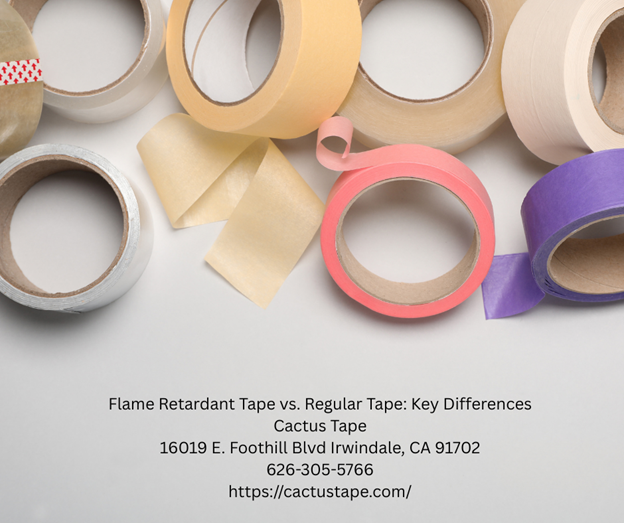- Home
- /
- Flame Retardant Tape vs....
Flame Retardant Tape vs. Regular Tape: Key Differences

Flame Retardant Tape vs. Regular Tape: Key Differences
Flame retardant tape is designed for fire safety, using specialized materials that resist ignition and slow flame spread, making it essential in high-risk environments. In contrast, regular tape is a versatile adhesive for everyday tasks, lacking the robust protective features of its flame-resistant counterpart.
While both serve unique purposes, understanding their properties and applications can help you choose the right tape for your needs. There’s more to explore about these differences and their implications.
Defining Flame Retardant Tape and Regular Tape
Flame retardant tape is a specialized adhesive tape designed to resist ignition and slow the spread of flames. Made with flame-retardant materials and specific additives, this tape is engineered to meet safety standards and protect surfaces in high-risk environments, such as electrical insulation, automotive, and construction projects. Its primary purpose is to reduce fire hazards and protect against fire-related incidents.
Regular tape, on the other hand, is a versatile tool used in everyday applications. It’s commonly found in homes, offices, and schools and comes in various types for specific needs. While regular tape serves a broad range of purposes, flame retardant tape offers critical protection in high-risk environments, making it essential for fire safety.
Properties of Flame Retardant Tape vs. Regular Tape
When choosing tape for your project, it’s essential to understand the distinctions between high-quality flame retardant tapes, and regular tape. This comparison will help you decide which tape best suits your needs, ensuring optimal performance and safety.
Flame Retardant Tape
Flame retardant tape is designed to provide exceptional heat resistance, making it an essential tool in high-temperature environments where fire hazards are a concern. Here are some key features of flame retardant tape:
- Heat Resistance: Flame retardant tape can withstand extreme temperatures, with a high melting point and enhanced durability, reducing fire hazards.
- Ignition Resistance: It resists ignition, providing an added layer of protection in environments where fire is a risk.
- Low Smoke Emission: During exposure to flames, it emits minimal smoke, contributing to a safer environment.
- Compliance with Safety Standards: This tape meets rigorous fire safety regulations, ensuring it meets industry-specific benchmarks for safety and performance.
Choosing flame retardant tape means you’re investing in a product that adheres to strict safety standards, offering peace of mind and reliable performance in high-risk environments.
Regular Tape
Regular tape, while versatile for everyday applications, has distinct properties that differ significantly from flame retardant tape. Here’s what you should know about regular tape:
- Adhesive Strength: Regular tape comes in various adhesive types, with strength varying based on the intended use. Common types include general-purpose adhesive for light tasks, double-sided tape for mounting, and duct tape for strong, durable holds.
- Temperature Resistance: Regular tape has limited temperature resistance, typically handling temperatures up to about 200°F (93°C). Beyond this range, the adhesive can break down, causing loss of stickiness in high heat or brittleness in cold conditions.
- Durability: The durability of regular tape depends on the adhesive quality, material composition, and environmental conditions. Regular tape may wear down more quickly in harsh conditions compared to flame retardant options.
In contrast to flame retardant tape, regular tape doesn’t offer the same level of heat resistance or safety certifications, making it unsuitable for high-risk environments where fire safety is critical.
Applications of These Tapes
Flame retardant tape and regular tape are used in different ways, each serving specific needs.
Flame retardant tape is essential in industries where safety is a top concern. It is commonly used in manufacturing, construction, aerospace, and automotive sectors to secure wires and cables, preventing electrical hazards and reducing the risk of fires. Its heat resistance makes it vital for fire prevention strategies, ensuring safety in high-risk environments.
On the other hand, regular tape is incredibly versatile for everyday tasks around the home and office. It’s commonly used for gift wrapping, crafting, sealing boxes, labeling, and quick repairs. While not designed for high-risk applications, regular tape provides an easy solution for a wide range of simple projects.
Safety Standards and Regulations
Understanding safety standards and regulations is vital for anyone considering the use of flame retardant tape. These tapes must meet specific criteria to guarantee they provide the necessary protection against fire hazards.
Understanding safety standards is important when choosing flame retardant tape. These tapes must meet criteria set by organizations like ASTM and UL to ensure fire protection. Look for products with safety certifications, which confirm rigorous testing and compliance. Prioritize certified tapes for reliable fire risk reduction in residential and commercial settings. Always verify these details before purchasing.
Frequently Asked Questions
Can Flame Retardant Tape Be Used Outdoors?
You’ll love that flame retardant tape offers outdoor durability and weather resistance. It can withstand harsh conditions, ensuring your projects stay safe and secure, no matter what Mother Nature throws your way.
How Long Does Flame Retardant Tape Last?
Flame retardant tape typically lasts several years, depending on durability factors like exposure to sunlight, moisture, and temperature fluctuations. Its flame resistance remains effective when stored properly, ensuring long-lasting performance in critical applications.
Is Flame Retardant Tape Reusable?
Flame retardant tape isn’t designed for reusability. While its lifespan can be impressive, its reusability benefits are limited. You’ll find that using fresh tape often guarantees better performance and safety in critical applications.
What Materials Are Used in Flame Retardant Tape?
Flame retardant tape typically uses materials like fiberglass or silicone, providing excellent adhesive properties and heat resistance. These features guarantee the tape can withstand high temperatures while maintaining its sticking power in demanding environments.
How Does Flame Retardant Tape Impact Adhesion Strength?
Flame retardant tape enhances adhesion performance due to its unique formulation. Its thermal resistance allows it to maintain a strong bond under high temperatures, ensuring your projects stay secure even in challenging environments without compromising safety.




